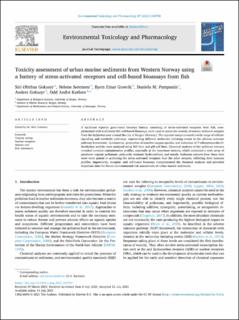Toxicity assessment of urban marine sediments from Western Norway using a battery of stress-activated receptors and cell-based bioassays from fish
Goksøyr, Siri Øfsthus; Sørensen, Helene; Grøsvik, Bjørn Einar; Pampanin, Daniela Maria; Goksøyr, Anders; Karlsen, Odd André
Peer reviewed, Journal article
Published version
Permanent lenke
https://hdl.handle.net/11250/2836308Utgivelsesdato
2021Metadata
Vis full innførselSamlinger
- Articles [3012]
- Publikasjoner fra CRIStin [3070]
Originalversjon
Environmental Toxicology and Pharmacology. 2021, 87:103704 1-10. 10.1016/j.etap.2021.103704Sammendrag
A luciferase reporter gene-based bioassay battery consisting of stress-activated receptors from fish, complemented with traditional fish cell-based bioassays, were used to assess the toxicity of marine sediment samples from the Byfjorden area around the city of Bergen (Norway). The reporter assays covered a wide range of cellular signalling and metabolic pathways, representing different molecular initiating events in the adverse outcome pathway framework. Cytotoxicity, generation of reactive oxygen-species, and induction of 7-ethoxyresorufin-O-deethylase activity were analysed using fish liver and gill cell lines. Chemical analyses of the sediment extracts revealed complex contamination profiles, especially at the innermost stations, which contained a wide array of persistent organic pollutants, polycyclic aromatic hydrocarbons, and metals. Sediment extracts from these sites were more potent in activating the stress-activated receptors than the other extracts, reflecting their toxicant profiles. Importantly, receptor- and cell-based bioassays complemented the chemical analyses and provided important data for future environmental risk assessments of urban marine sediments.
